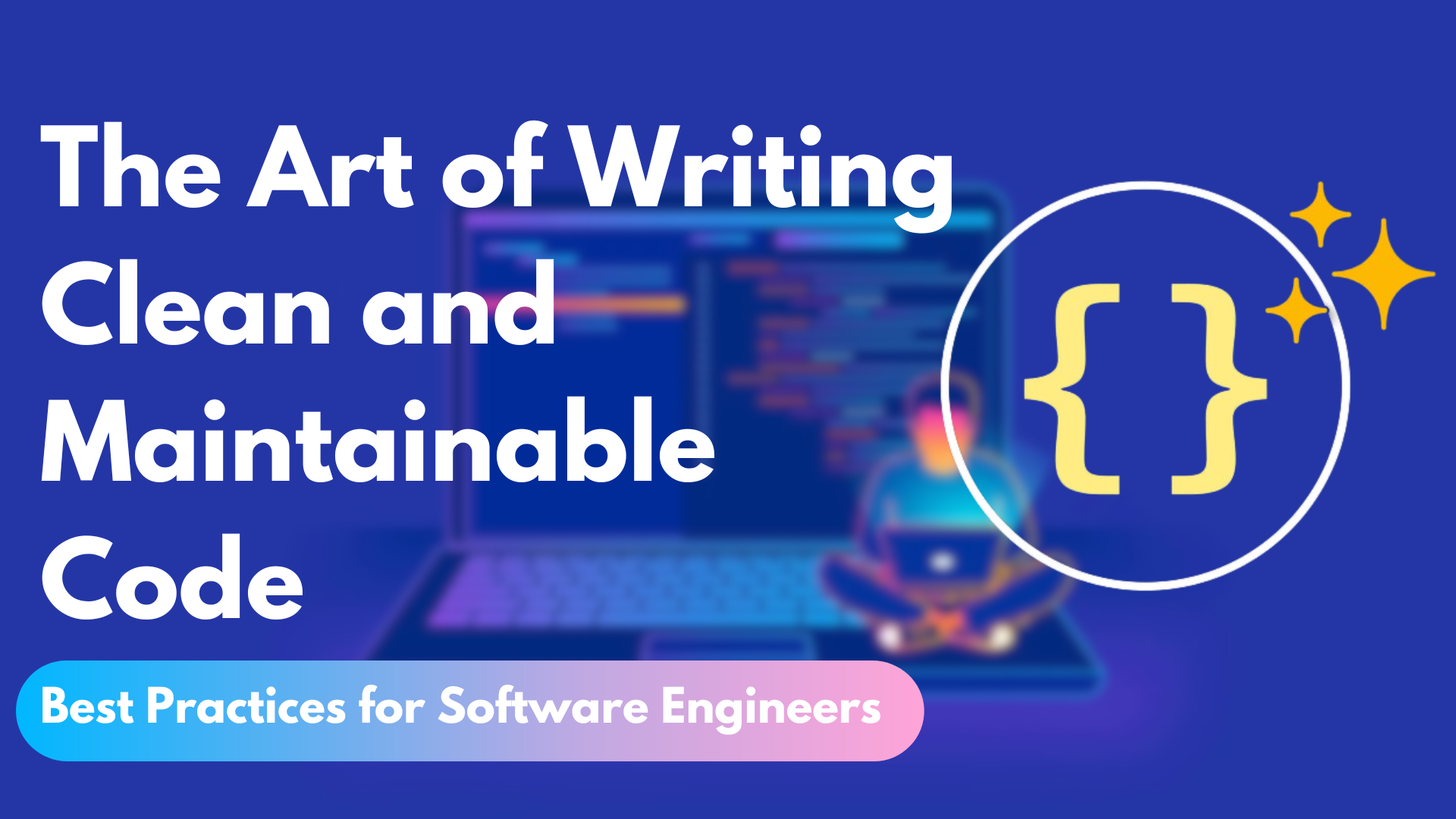In today’s world, software has become a fundamental part of our lives. It powers everything from the devices we use to the services we rely on. As a software engineer, it is essential to understand the importance of writing clean and maintainable code. Writing code that is easy to read, understand, and maintain is crucial for the long-term success of any software project. In this article, we will explore the art of writing clean and maintainable code, and the best practices that software engineers can use to achieve that goal.
Introduction to Writing Clean and Maintainable Code
Writing clean and maintainable code is a critical aspect of software development. It not only ensures that the application runs smoothly but also makes the code easier to maintain and improve over time. In this article, we will discuss the best practices for writing clean and maintainable code that every software engineer should know.
Clean code is code that is easy to read, understand, and maintain. It is code that is well-organized, free from unnecessary complexity, and adheres to coding conventions and best practices. Clean code is not only functional but also easy to modify and extend over time.
Code Quality
Code quality is a term used to describe the standard of code that meets the expectations of stakeholders. It includes many factors such as readability, maintainability, extensibility, and performance. Clean and maintainable code is an essential component of code quality that ensures the application runs smoothly, and the code is easy to change and adapt to new requirements.
The Impact of Code Quality on Software Development
Code quality is a critical factor in software development. Poor quality code can lead to several issues such as bugs, crashes, and security vulnerabilities. It can also make the codebase difficult to maintain and costly to improve over time. High-quality code, on the other hand, can lead to faster development, fewer bugs, and improved security. It also reduces the cost of maintenance and makes continuous improvement easier.
Benefits of Writing Clean and Maintainable Code
Writing clean and maintainable code has several benefits.
- It makes the code easier to understand, change, and improve over time.
- It also makes it easier to identify and fix bugs, reducing the risk of crashes and security vulnerabilities.
- Clean and maintainable code also reduces the cost and time required for maintenance and improvements, making development more efficient and cost-effective.
The Consequences of Ignoring Code Quality
Ignoring code quality can lead to several consequences, such as:
- Increased development time, higher development costs, and a poor user experience.
- Poor code quality can also lead to frequent crashes and security vulnerabilities, making it difficult to build user trust in the application.
Best Practices for Writing Clean and Maintainable Code
Use Consistent and Descriptive Naming Conventions
Using consistent and descriptive naming conventions for variables, functions, and classes makes the code easier to read and understand. It also makes it easier to identify and fix bugs and reduces the risk of naming conflicts.

In the bad example, inconsistent and non-descriptive naming conventions are used. The function Add uses single-letter variable names (x, y, s), which are not meaningful and do not convey the purpose of the variables. The class P uses a non-descriptive name and abbreviated variable names (n and a), making it harder to understand the purpose of the class and its member variables.
In the good example, consistent and descriptive naming conventions are used. The function CalculateSum uses meaningful variable names (number1, number2, sum), making it easier to understand the purpose of the variables and their relationship. The class Person uses a descriptive name and meaningful member variable names (Name, Age), providing clarity about the purpose of the class and its attributes. By using consistent and descriptive naming conventions, the code becomes more readable and easier to understand.
Write Clear and Concise Code
Clear and concise code is more readable and easier to understand. It also reduces the risk of introducing bugs and makes it easier to identify and fix them. Concise code is also more efficient and reduces the amount of work required to maintain and improve the code over time.

In the bad example, the code is not clear and concise. It uses a for loop with explicit index manipulation to iterate over the elements of the array, which adds unnecessary complexity. The variable names are also not descriptive, making it harder to understand the code’s purpose.
In the good example, the code is clear and concise. The LINQ Sum method is used directly on the array, eliminating the need for a loop and explicit index manipulation. The variable name total is more descriptive, making it easier to understand the purpose of the code. The revised code is shorter, more readable, and reduces the chances of introducing bugs.
Minimize Code Complexity
Complex code is difficult to read and understand. It also increases the risk of bugs and makes it more challenging to maintain and improve the code over time. Minimizing code complexity by breaking it into smaller, simpler parts makes it easier to understand and reduces the risk of bugs.

In the bad example, the code has high complexity due to multiple responsibilities within a single method. The method performs both the summation and the calculation of the average, resulting in less maintainable code. The loop adds unnecessary complexity for summing the elements, and the division operation for the average calculation can potentially lead to division by zero if the list is empty.
In the good example, the code complexity is minimized by breaking the functionality into smaller, more focused methods. The CalculateAverage method now delegates the responsibility of summing the numbers to a separate helper method called SumNumbers. This separation of concerns improves readability and makes the code easier to understand. Additionally, the code checks for an empty list to handle the division by zero case, ensuring the code handles such scenarios gracefully.
Avoid Code Duplication
Code duplication increases the risk of bugs and makes it harder to maintain and improve the code. Avoiding code duplication by using functions and classes reduces the amount of work required to maintain the code and makes it easier to identify and fix bugs.

In the bad example, code duplication exists in the temperature conversion methods. Both ConvertToCelsius and ConvertToFahrenheit perform similar calculations with slight variations. This redundancy violates the DRY principle and increases the chances of introducing inconsistencies if modifications are required.
In the good example, the code has been improved by eliminating the code duplication. Both conversion methods now use a single parameter temperature instead of separate parameters for Celsius and Fahrenheit. This approach avoids redundant code and maintains clarity. By keeping the code DRY, future modifications or enhancements can be applied consistently to both conversion methods.
Writing Code for Readability and Clarity
Effective Use of Comments
Comments are an essential component of code readability. They explain the purpose of the code and how it works, making it easier to read and understand. Effective use of comments can also reduce the risk of bugs and make it easier to maintain and improve the code over time.
1 2 3 4 5 6 7 8 9 10 11 12 13 14 15 16 17 18 19 20 21 22 23 24 25 |
// Calculate the factorial of a given number // Returns the factorial value public int CalculateFactorial(int number) { if (number < 0) { throw new ArgumentException("Number must be non-negative."); } // Base case: factorial of 0 is 1 if (number == 0) { return 1; } int factorial = 1; // Multiply the factorial by each number from 1 to the given number for (int i = 1; i <= number; i++) { factorial *= i; } return factorial; } |
In this example, comments are used effectively to enhance code understanding:
- The method is preceded by a comment that describes its purpose clearly: to calculate the factorial of a given number.
- A comment inside the method explains the base case when the number is 0, returning 1 as the factorial value.
- A comment before the loop indicates that the loop multiplies the factorial by each number from 1 to the given number.
- A comment in the if statement checks for negative numbers, providing a meaningful error message when an invalid input is detected
These comments help readers understand the logic, purpose, and edge cases of the code. They provide valuable context and guidance for both the original developer and future maintainers. By using comments effectively, the code becomes more self-explanatory and easier to maintain over tim
Choosing the Right Data Structures and Algorithms
Choosing the right data structures and algorithms improves application performance and reduces the risk of bugs. It also makes it easier to maintain and improve the code over time.
1 2 3 4 5 6 7 8 9 10 11 12 13 14 15 16 17 18 19 20 21 22 23 24 25 26 27 28 |
// Find the first occurrence of a target value in a sorted array // Returns the index of the target value, or -1 if it is not found public int BinarySearch(int[] sortedArray, int target) { int left = 0; int right = sortedArray.Length - 1; while (left <= right) { int mid = left + (right - left) / 2; if (sortedArray[mid] == target) { return mid; } if (sortedArray[mid] < target) { left = mid + 1; } else { right = mid - 1; } } return -1; } |
In this example, the code demonstrates the effective use of a binary search algorithm to find the first occurrence of a target value in a sorted array:
- The function uses a binary search algorithm, which is suitable for searching in a sorted array.
- It takes in a sorted array and a target value as input parameters. The function uses two pointers,
leftandright, to determine the search range within the array. - It iteratively compares the target value with the middle element of the current range.
- If the middle element matches the target value, it returns the index.
- If the middle element is less than the target value, the search range is adjusted to the right half of the array.
- If the middle element is greater than the target value, the search range is adjusted to the left half of the array.
- If the target value is not found after the search, it returns -1.
By using the binary search algorithm, the code achieves efficient searching in a sorted array with a time complexity of O(log n). This choice of algorithm ensures optimal performance compared to a linear search algorithm, especially for large-sized arrays. Choosing the right algorithm and data structure for specific tasks is crucial for optimizing code performance and reducing complexity.
Writing Self-Documenting Code
Self-documenting code uses descriptive variable and function names and is easy to read and understand. It reduces the need for comments and makes it easier to maintain and improve the code over time. Writing self-documenting code is an essential component of code readability and clarity.
1 2 3 4 5 6 7 8 9 10 11 12 13 |
// Calculate the total price of items in a shopping cart public decimal CalculateTotalPrice(List<CartItem> cartItems) { decimal totalPrice = 0; foreach (CartItem cartItem in cartItems) { decimal itemPrice = cartItem.Price * cartItem.Quantity; totalPrice += itemPrice; } return totalPrice; } |
In this example, the code is written in a self-documenting manner by using descriptive variable and function names:
- The method
CalculateTotalPriceclearly indicates its purpose of calculating the total price of items in a shopping cart. - The parameter
cartItemsis named in a way that reflects its meaning, representing a list ofCartItemobjects. - The variable
totalPriceholds the cumulative sum of item prices, indicating its purpose effectively. - The
foreachloop iterates through eachCartItemin thecartItemslist, making it easy to understand the logic. - The variable
itemPricerepresents the calculated price for a single item, adding to the clarity of the code.
By choosing meaningful and descriptive names for variables and functions, the code becomes self-explanatory. It reduces the need for excessive comments to explain the code’s intent, as the code itself conveys the purpose and logic clearly. Writing self-documenting code improves code readability and makes it easier to maintain and enhance over time
Code Maintainability
As a software engineer, writing code that is maintainable is crucial for ensuring that your software works efficiently and can be easily updated in the future. Here are some techniques for enhancing code maintainability.
Designing for Change
One of the most important ways to ensure code maintainability is to design for change. This means anticipating changes in requirements and designing the code to be flexible enough to accommodate them. One approach to designing for change is to use the SOLID principles of software design.
Keeping Code Modular and Reusable
Keeping code modular and reusable is another key technique for enhancing code maintainability. Modularity involves breaking down a program into smaller, simpler, and more manageable components. This makes it easier to identify and fix problems, as well as modify and extend the software over time.
Implementing Error Handling and Exception Management
Implementing error handling and exception management is also crucial for maintaining code. Error handling involves identifying and responding to errors that occur during program execution, while exception management involves handling unexpected events that occur in the program. Properly implemented error handling and exception management can help ensure that your program runs smoothly and avoids unexpected crashes.
Strategies for Code Refactoring and Optimization
Code refactoring and optimization are essential techniques for improving software performance and scalability. Here are some strategies for achieving this:
Identifying Code Smells
Code smells are symptoms of poor program design that can lead to maintenance problems and software bugs. Identifying code smells is the first step in optimizing your code. Common code smells include duplicate code, long methods, and large classes.
Principles of Code Refactoring
Code refactoring involves making changes to the code without modifying its external behavior. The goal is to improve the design and structure of the code while maintaining its functionality. Refactoring principles include keeping code DRY (Don’t Repeat Yourself), removing dead code, and simplifying code paths.
Optimizing Code for Performance
Optimizing code for performance involves identifying code that is causing performance bottlenecks and optimizing it to run more efficiently. This may involve changes to algorithm design or simply optimizing existing code through techniques such as caching or lazy loading.
Implementing Code Documentation and Testing
Proper documentation and testing are critical for maintaining code quality. Here are some strategies for implementing these practices:
Code Documentation
Code documentation is essential for maintaining code quality. It provides a clear understanding of the code structure, functionality, and purpose. Properly documented code reduces the risk of errors and enables easier maintenance and modification.
Types of Code Documentation
There are several types of code documentation, including
- Comments within code
- Function and method documentation.
- External documentation.
Commenting within code provides context for tasks and functions being performed, while function or method documentation provides information about the function’s parameters, return types, and behavior. External documentation is usually in the form of a user manual or help files.
Writing Effective Unit Tests
Unit testing is the practice of writing automated tests for individual units of code to ensure that they are functioning correctly. Effective unit tests should be comprehensive, easy to maintain, and test for all possible scenarios.
Writing clean and maintainable code is an ongoing process that requires constant attention and effort. Implementing the techniques and strategies outlined in this article can help improve code maintainability, optimize performance, and ensure that code quality remains high.
Conclusion
There are many resources available for improving code quality, including books, online courses, and community forums. Some popular resources include Code Complete by Steve McConnell, Clean Code by Robert C. Martin, and the Clean Coders video series. Additionally, many online communities, such as StackOverflow and GitHub, are great resources for finding answers to specific coding problems and learning from experienced developers.In conclusion, writing clean and maintainable code is a critical skill for any software engineer. By following the best practices outlined in this article, developers can write code that is easy to read, understand, and maintain. Writing quality code is an ongoing process, and engineers should continuously strive to improve their skills and knowledge. With dedication and practice, developers can produce software that is not only functional but also easy to maintain and extend over time.





